Fishing Spawning Enhancement
About the Project
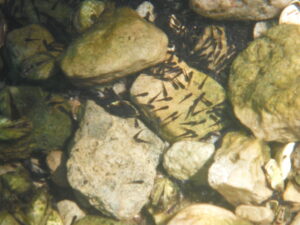 Otty Lake and the RVCA have partnered to improve fish habitat in Otty Lake. This project is the single largest initiative to rehabilitate and enhance spawning grounds for bass ever undertaken in Eastern Ontario, and has received critical acclaim in the conservation community.
Otty Lake and the RVCA have partnered to improve fish habitat in Otty Lake. This project is the single largest initiative to rehabilitate and enhance spawning grounds for bass ever undertaken in Eastern Ontario, and has received critical acclaim in the conservation community.
In the fall of 2013, volunteers worked to deposit pea gravel to establish 92 new spawning beds, and submerged over 50 small trees to provide feeding, sheltering and resting areas for fish. Monitoring took place to assess the usage of the new nest sites and sunken wood structures,
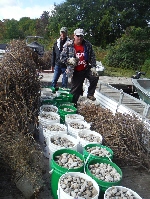 In September 2014, volunteers contributed 240 hours over two days to continue the the project. The results of Phase II were:
In September 2014, volunteers contributed 240 hours over two days to continue the the project. The results of Phase II were:
- 83 spawning beds installed for smallmouth bass
- 185 sunken wood clusters installed to provide shelter and feeding habitat
- 58 cornerstone installations at various nests to provide cover for guarding males.
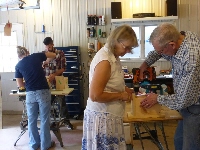 On September 21, 2015, 27 volunteers contributed a total 189 hours to to Phase III of the project, installing:
On September 21, 2015, 27 volunteers contributed a total 189 hours to to Phase III of the project, installing:- 49 spawning beds
- 75 cornerstones
- 9 brush bundles
- 8 wood duck nesting boxes and 7 swallow boxes, with more to be delivered and installed
The nesting boxes were cut and assembled by volunteers a couple of weeks earlier. (Photo by Jay Hendry.)
Phase IV of the project took place in 2016, thanks to a $5050 grant awarded to the OLA and RVCA from the TD Bank – Friends of the Environment Fund.
Jennifer Lamoureux from RVCA gave a presentation on this project at our July 2016 AGM, which included some neat underwater photos. A video showing a pair of smallmouth bass spawning on one of the installed spawning beds from the Otty Lake fish and wildlife enhancement project is available on youtube: https://www.youtube.com/watch?v=qffSxTW0Uh4.
Resources
The RVCA’s Otty Lake Fish Habitat Improvement page.
See Jennifer Lamoureux’s presentation on the project made at the OLA AGM July 12, 2014.
RVCA News Release Oct. 6, 2014 – Volunteers “Rock” Otty Lake’s Phase II Fish Habitat Enhancement Project
Project Contacts:
Wally Robins, Otty Lake Association
Jennifer Lamoureux, Aquatic and Fish Habitat Biologist, RVCA, 613-692-3571 ext. 1108
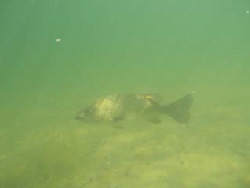 Historical Context
Historical Context
by Wally Robins
Otty Lake had housed a healthy smallmouth bass population for decades. Flourishing sub-populations of year classes (size ranges) were constant. In the late 70s, lake characteristics changed with the spread of more aquatic vegetation and gradually increasing average water temperatures. These natural environmental changes did not negatively impact the smallmouth fishery and, in fact, contributed to its overall health.
Roughly 7-8 years ago, the smallmouth population started to decline. In particular, the number of adult fish began to trend downward and was consistent over a span of almost a decade. This trend was noted in creel data I have kept for close to 30 years. Creel data is a record of every bass caught annually by sub-species (smallmouth versus largemouth by size range (under 1 pound, 1 to 2 pounds, 2 to 3 pounds, etc). An “adult” smallmouth is a fish that is 2 pounds or above. A 2 pound smallmouth in Otty Lake is approximately 5-6 years old.
What Caused the Population Decline?
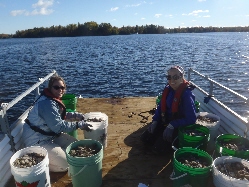 To understand the probable cause of the decline in the smallmouth population, we must start with an understanding of the factors necessary for the maintenance of a healthy fishery. There are four. The first two are a supply of clean water and a sufficient forage base (food source). Otty did, and still does, score high marks in both these criteria. It is also critical that fish are protected during their most vulnerable time, during the spawning cycle, and that adult fish, the owns that participate in the spawn, are responsibly harvested. It is the latter two factors that created an unhealthy imbalance in the population. Far too many large smallmouth bass were being caught and killed annually and out-of-season bass fishing in May and early June was problematic on Otty. (This knowledge was gained from extensive literature research and a lengthy series of former and current fish biologists of MNR and other conservation organizations).
To understand the probable cause of the decline in the smallmouth population, we must start with an understanding of the factors necessary for the maintenance of a healthy fishery. There are four. The first two are a supply of clean water and a sufficient forage base (food source). Otty did, and still does, score high marks in both these criteria. It is also critical that fish are protected during their most vulnerable time, during the spawning cycle, and that adult fish, the owns that participate in the spawn, are responsibly harvested. It is the latter two factors that created an unhealthy imbalance in the population. Far too many large smallmouth bass were being caught and killed annually and out-of-season bass fishing in May and early June was problematic on Otty. (This knowledge was gained from extensive literature research and a lengthy series of former and current fish biologists of MNR and other conservation organizations).
Partnering with RVCA In 2013, OLA partnered with the Rideau Valley Conservation Authority (RVCA) and, to a lesser degree, with the Ministry of Natural Resources (MNR) to fund and lead a smallmouth bass spawning habitat enhancement project. A total of $2,500 was ear-marked for the initiative with RVCA covering $2,000 of that. | 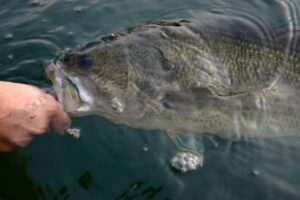 |
Spawning Beds Required
Research conducted by Dr. Mark Ridgeway, the world’s leading authority on smallmouth bass, strongly recommends the creation of new spawning nest sites as the single most important action to improve a smallmouth population. As a result, the majority of project work on Otty was dedicated to this.
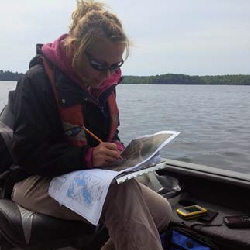 Identifying Potential Sites
Identifying Potential Sites
The initial step was to tour Otty to identify high potential areas for enhancement. Two tours of Otty occurred in June and early July of 2013. Potential spawning locations were prioritized using a “high”, “medium” and “low” rating. Rating criteria was based on the size of the area, water depth, the type of bottom strata (hard versus soft), historical spawning usage, prevailing wind direction, number of resident pan fish (predators of eggs and bass fry), and availability of “drop back” zones for post spawn female bass. (A drop back zone is a deeper water area adjacent to spawning sites. Ideal characteristics include a ready supply of forage and underwater cover, like wood or vegetation. Female smallmouth are very lethargic and energy spent after spawning and require the security/ safety of deeper water (15-25 feet) and easily acquired food in order to replenish body weight lost during the spawn). Once Otty had been surveyed and various sites identified, RVCA produced a geospatial map, colour coded and gridded to be used as a reference document for project work.
Wood Structures Submerged
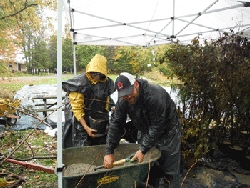 The second phase of the project took place in October 2013 over a two day period. RVCA provided 10-12 staff and two Otty Lake property owners contributed to the work. Roughly 60 wood structures were built. These structures were 5-7 foot trees/tree limbs anchored in two gallon plastic pots with cement. (The plastic was cut off the structure prior to being submerged). As well, five tons of washed rock (pieces of stone roughly the size of a fist) were loaded into pails and carried to a pontoon boat for transporting to enhancement areas.) Each pail represented the size of a natural spawning nest . Rock was dropped in high priority sites in 2 to 6 feet of water. Wood was deposited in “drop back” zones in depths no shallower than 15 feet to insure safe navigation and swimming for Otty Lake residents. GPS coordinates were registered for each area to assist in follow up monitoring which will occur in May and June of 2014. In total, 92 new spawning nests were created. This project is the single largest initiative to rehabilitate and enhance spawning grounds for bass ever undertaken in Eastern Ontario. It has received critical acclaim in the conservation community.
The second phase of the project took place in October 2013 over a two day period. RVCA provided 10-12 staff and two Otty Lake property owners contributed to the work. Roughly 60 wood structures were built. These structures were 5-7 foot trees/tree limbs anchored in two gallon plastic pots with cement. (The plastic was cut off the structure prior to being submerged). As well, five tons of washed rock (pieces of stone roughly the size of a fist) were loaded into pails and carried to a pontoon boat for transporting to enhancement areas.) Each pail represented the size of a natural spawning nest . Rock was dropped in high priority sites in 2 to 6 feet of water. Wood was deposited in “drop back” zones in depths no shallower than 15 feet to insure safe navigation and swimming for Otty Lake residents. GPS coordinates were registered for each area to assist in follow up monitoring which will occur in May and June of 2014. In total, 92 new spawning nests were created. This project is the single largest initiative to rehabilitate and enhance spawning grounds for bass ever undertaken in Eastern Ontario. It has received critical acclaim in the conservation community.
Expectations
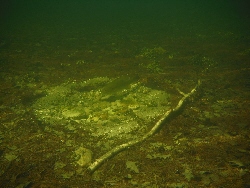 Will the smallmouth population in Otty improve tomorrow? No. Results will not be seen for a number of years as it takes 5-7 years to “grow” an adult bass In Eastern Ontario. Indicators of project success will be viewed in the short term however if a percentage of the new nests are used during the spawning period in 2014 through 2016. Note please that there are other benefits to work done on this project. The wood structures dropped into Otty will become resting, breeding and feeding areas for other fish species as well as for many other underwater residents like crawfish, invertebrates and insect life. The same is true for newly created rock nest sites.
Will the smallmouth population in Otty improve tomorrow? No. Results will not be seen for a number of years as it takes 5-7 years to “grow” an adult bass In Eastern Ontario. Indicators of project success will be viewed in the short term however if a percentage of the new nests are used during the spawning period in 2014 through 2016. Note please that there are other benefits to work done on this project. The wood structures dropped into Otty will become resting, breeding and feeding areas for other fish species as well as for many other underwater residents like crawfish, invertebrates and insect life. The same is true for newly created rock nest sites.
More Information
Project Volunteers 2013
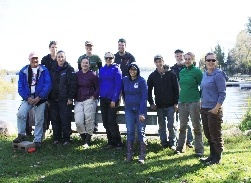
Project Volunteers 2014
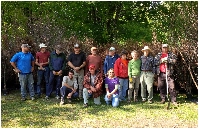
Project Volunteers 2015
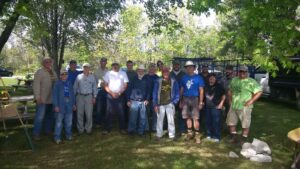
Nest Box Volunteers 2015
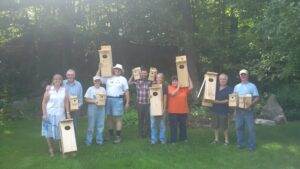
Occupied Nesting Box, Maple Glen, Spring 2016
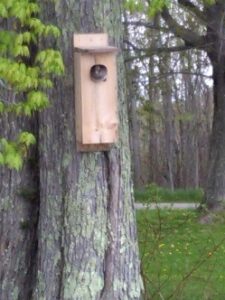
Bat Box Volunteers 2016
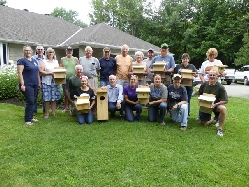
Wood Duck Nest Box Maintenance
If you have one of these boxes, be sure to clean it out and put in a fresh supply of wood shavings (not sawdust) in the fall or winter. Cavity-nesting ducks do not carry nesting materials and won’t choose an empty box. Boxes are often not used the first year, but a duck may check it out for use the next year, so make sure it passes inspection!
